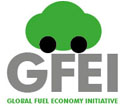
Accessing International Financial Support Mechanisms for Vehicle Fuel Economy: A Guide for Developing Country Governments
1. Introduction
Improving auto fuel economy makes economic sense on many levels – from foreign exchange reserves, to fuel import costs and national budgets, to consumer wallets. The well-documented economic and social benefits of acting on fuel economy are summarized in this section of the Tool.
Yet despite the apparent benefits, most developing and emerging economies lack policies designed to lower the energy use by automotive fleets and encourage more efficient technology. The Global Fuel Economy Initiative (GFEI) has outlined the policy instruments and technical options available to decision makers when it comes to fuel economy.
To supplement this guidance on policy and technology packages, the GFEI has also published information on “Accessing International Financial Support Mechanisms for Vehicle Fuel Economy: A Guide for Developing Country Governments.” The document features guidance on: current sources of international funding to support national efforts to improve vehicle fuel efficiency and how to access the international financial mechanisms..
There are only a few main sources of funding sources that governments can draw on to support public efforts to improve energy efficiency in road transport. These include:
- National revenue (including fuel taxes),
- various specialized economic instruments that include feebates (essentially a fee on inefficient technology and a rebate on efficient vehicles which are, ideally, revenue neutral), buy-back programmes, vehicle registration fees, penalties on vehicle manufacturers for failure to meet fuel economy/consumption standards and international funding mechanisms. These mechanisms include bilateral, public, and private sources of financial and technical support (mainly in the form of project and programme grants).

The guidance report also details the sources of funding, structured by geographic region, and relevant funds, including for Asia, Europe, Africa, and Central and South America and the Caribbean. In addition, the report summarizes ways to increase the likelihood of obtaining financial support for vehicle fuel economy measures, from increasing the domestic recognition of the need for vehicle fuel economy (which the GFEI works with countries to do), to ensuring that a supportive legislative framework is in place, to developing a robust business case, initiating dialogue with financial institutions from an early stage, know the application and funding process (including the UNFCCC discussions related to climate change and energy efficiency) and collaborating with the private sector.
All regional lists of funding sources are available in the full report, but the table below gives an example of how this information is displayed for Asia.

The strategies and project portfolios of the institutions featured in the report indicate that financial support is potentially available for vehicle fuel economy measures, and that the availability of finance from these sources is likely to increase. This is linked in part to the increasing international emphasis on the need for climate change mitigation, as well as an expanding recognition of the imperative to improve energy efficiency for transport and the contribution of the transport sector to GHG emissions. It is important to note, however, that while there are many sources of funding available it can still be challenging to obtain finance for vehicle fuel economy measures. This relates both to the total volume of funds available and the many different sectors and types of interventions competing for these resources. The following pages contain examples of how some of these challenges could be overcome.
Certain funding mechanisms – including the World Bank, the Asian Development Bank, the Clean Development Mechanism, EuropeAid, the European Bank for Reconstruction and Development , the German International Climate Initiative, the Global Environment Facility, the Inter-American Development Bank, and the International Finance Corporation – are detailed in fact sheets in chapter 4. And within each mechanism various financial instruments are available. For example, within the World Bank the Carbon Partnership Facility, the Climate Investment Funds, the Energy Sector Management Assistance Programme, and the Partnership for Capacity Building Program in Africa are all potential sources of funding for auto fuel economy initiatives.
The Transport Knowledge Transfer Network also posts available funding opportunities relevant to energy efficiency in transport on its website. GIZ has also provided a helpful Overview of International Climate Funds for Urban Transport, along with UNEP’s Climate Change Finance under the Convention.








